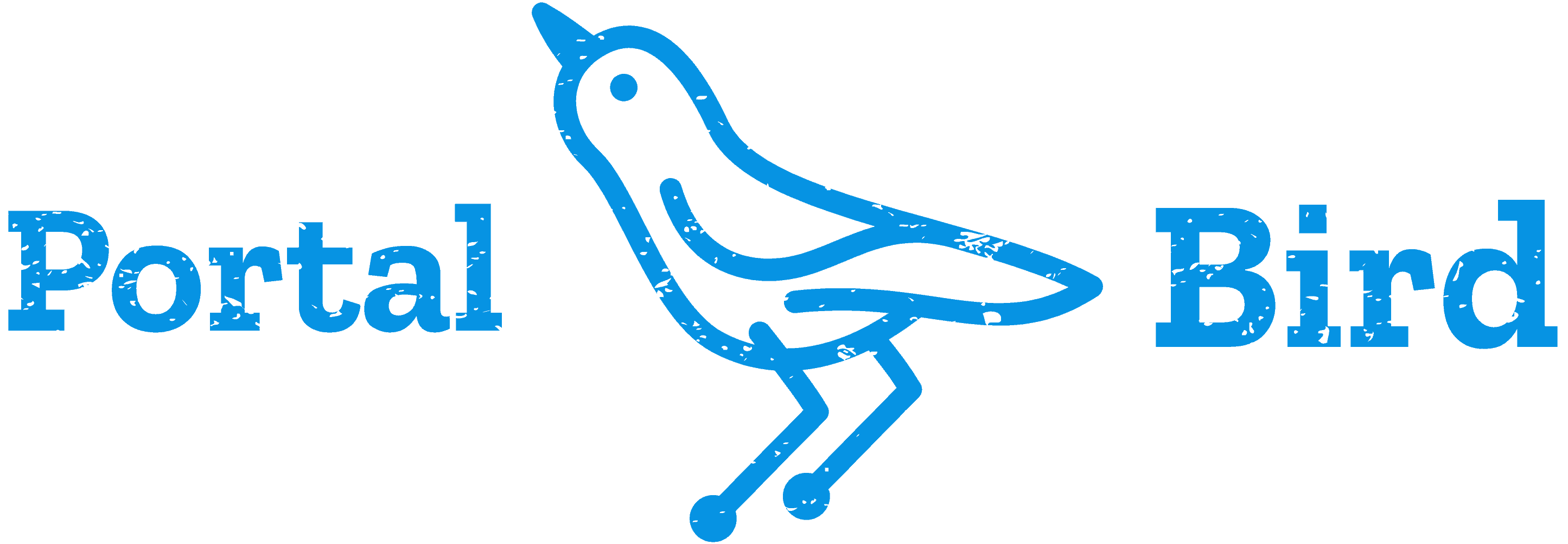Bird Feeding Etiquette
As an enthusiastic bird watcher with countless hours spent observing the delightful dance of birds in my own yard, I’ve come to see that feeding our winged visitors is more than just tossing seeds and hoping for the best.
It’s a careful balance of practices that enriches both their lives and ours. While some folks might worry that we’re making wild birds rely too much on our helping hands, studies have shown this concern is misplaced; offering food actually bolsters their survival in tough times while allowing us moments of heartwarming wonder.
When it comes to laying out those grains or hanging up feeders, however, there’s a vital piece of the puzzle often missed: etiquette. Believe it or not, even in the bustling realm of birds, good manners are key! Proper bird feeding etiquette doesn’t just preserve natural balances—it makes sure every feathered guest has a peaceful meal and keeps pesky intruders at bay.
So let’s explore this treasure trove of advice together on how to be outstanding hosts for our flying friends – wings spread and ready for adventure!
Key Takeaways
- Feeding birds the right way helps them survive tough times and lets us watch them up close.
- Give birds different foods like seeds, suet, and bugs, but don’t give them bread or salty snacks.
- Keep your bird feeders clean and put them where it’s safe for birds to eat without pesky animals bothering them.
- To stop too many birds from coming at once or the wrong kinds of birds from showing up, spread out where you put food and choose what you offer carefully.
- Look after nature when feeding birds by not hurting their normal ways of living and picking food that doesn’t make a mess or harm anyone.
Overview of Bird Feeding
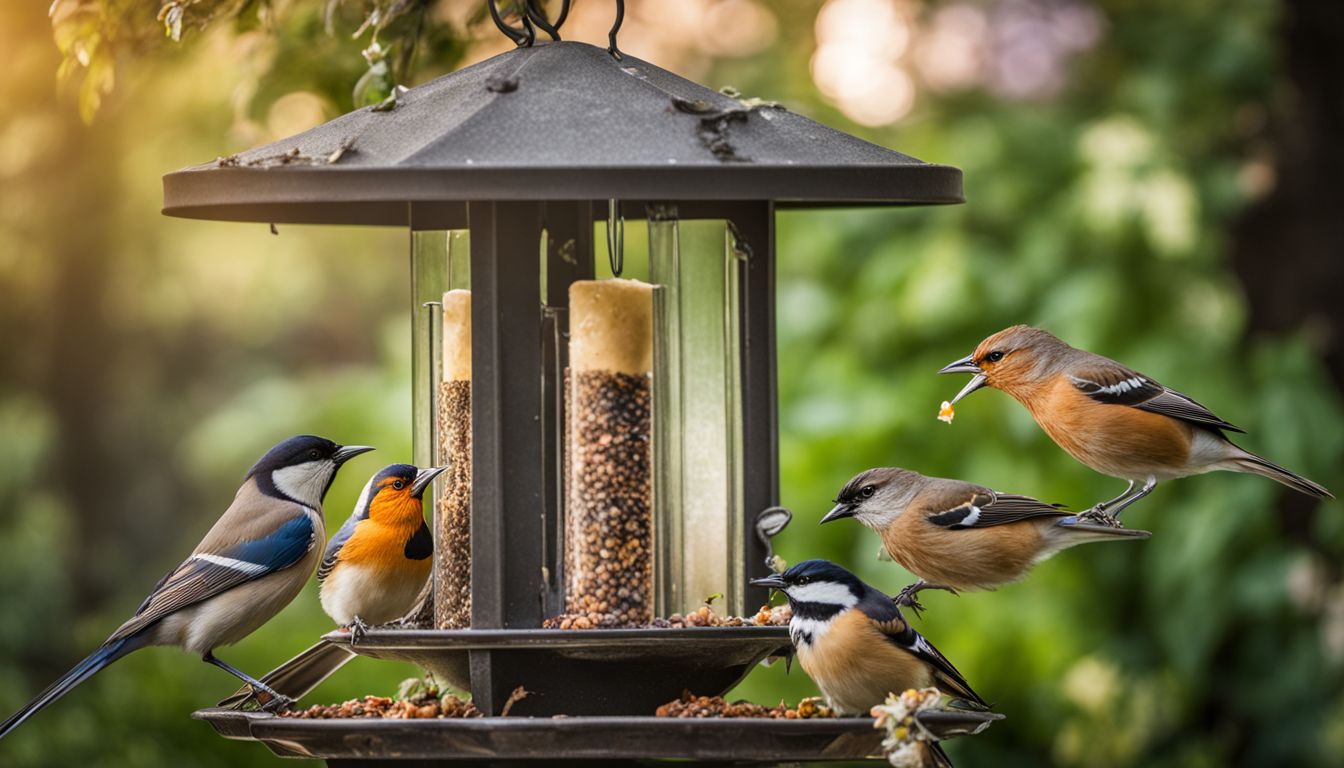
Feeding wild birds can bring joy and a sense of connection to nature for families, while also providing essential nutrition for the birds. However, there is controversy surrounding bird feeding, making it important to understand proper etiquette when offering food to our feathered friends.
Benefits for wildlife and families
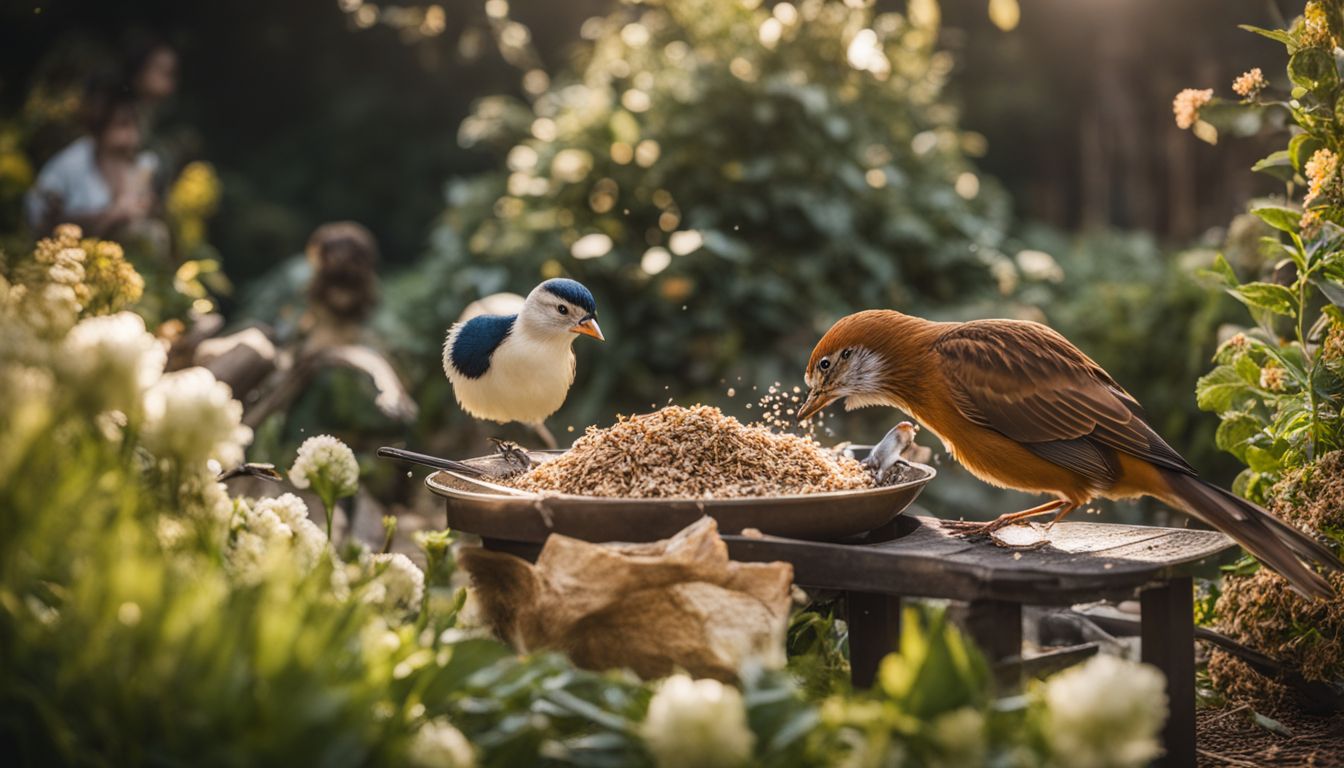
Birds get a lot from the seeds and suet we put out for them. They can find food easily, which is super helpful when it’s cold or when there isn’t much to eat outside. This means they can use their energy to stay warm and take care of their families instead of looking for food all the time.
Plus, watching birds come to our gardens brings us joy too! We learn about different kinds of birds and how they live, which helps us understand nature better. It’s great fun for kids and grown-ups alike.
Having bird feeders also lets lots of different bird species hang out together in one spot. This is awesome because we can see so many types at once without going far away from home! And don’t worry; giving them food doesn’t make them need us too much – they still do fine on their own just like always.
So this way, both birds and people win – we help our feathered friends, and they give us something beautiful to see every day!
Controversy surrounding feeding
Feeding birds may lead to controversy as some people argue that it can make birds dependent on humans or disrupt their natural behaviors. However, research suggests that this isn’t always the case.
It’s important to consider the impact bird feeding may have on the environment and other wildlife, as well as any laws or regulations in your area. By being mindful of these factors, we can ensure responsible and ethical bird feeding practices while enjoying the beauty of nature in our own backyard.
I hope this helps you understand the debate around bird feeding and how to approach it responsibly as a bird lover.
Importance of proper etiquette
Proper bird feeding etiquette is crucial to ensure the well-being of the birds and maintain a healthy environment. By respecting the natural behavior of birds and avoiding overfeeding, we can prevent overcrowding and minimize the risk of attracting non-native species.
Additionally, considering the impact on the environment helps in maintaining a balanced ecosystem. It’s important to be mindful of any regulations regarding bird feeding in your area to contribute to wildlife conservation efforts.
Respecting the natural behavior of birds and being mindful of any regulations helps maintain a balanced ecosystem, while also contributing to wildlife conservation efforts. Avoiding overfeeding prevents overcrowding and minimizes attracting non-native species, ensuring that proper bird feeding etiquette is in place for the well-being of birds and a healthy environment.
When and Where to Feed Birds
Consider the seasonal and geographic factors when choosing to feed birds in your backyard. Proper placement of feeders can also impact the safety and enjoyment of the feeding area for wildlife.
Seasonal and geographic considerations

In different seasons and locations, bird feeding needs change. Some birds may migrate, so it’s important to know which species are present in your area at various times of the year.
Providing suitable food for the local species during each season can attract a variety of birds to your feeders. For example, in colder months, high-energy foods like suet are beneficial, while in warmer months, offering a mix of seeds and live insects can accommodate diverse dietary preferences.
Understanding the seasonal and geographic factors that influence bird behavior helps create a welcoming environment for our feathered friends.
Feeding wild birds depends on where you are and what time of year it is. Different bird species might be around at different times, so it’s essential to offer appropriate food based on these factors to attract a range of birds.
For instance, when it’s cold outside, providing high-energy foods like suet can benefit them; whereas when it’s warm out, having an assortment of seeds and live insects available can suit their varied diets better.
Placement of feeders
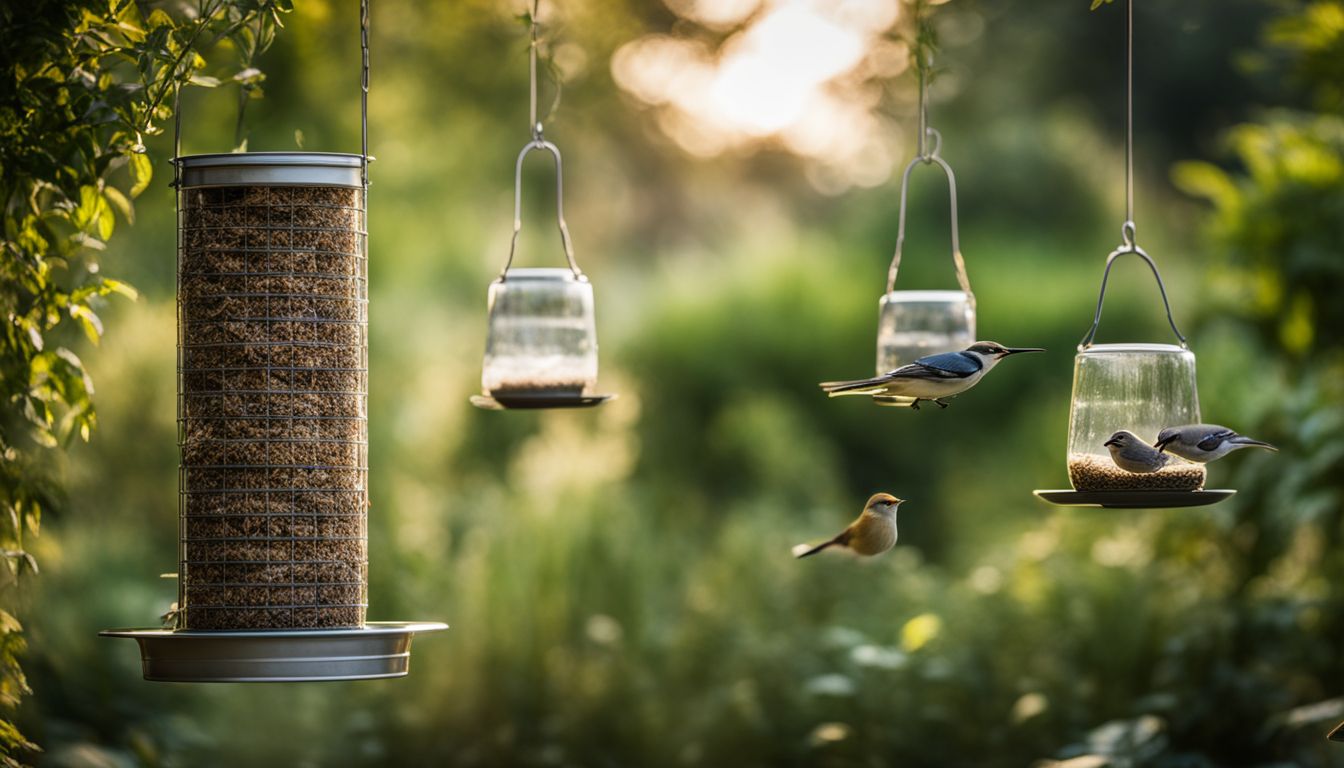
I choose different spots in my garden to hang the bird feeders. I place them at various heights to attract many kinds of birds. This way, I can enjoy watching a wide variety of beautiful birds visit my garden.
It’s essential to put feeders away from windows and outdoor areas where predators could lurk. Placing the feeders near shrubs or trees gives our feathered friends a safe space if they need it.
It is important to keep an eye on the surroundings when deciding where to hang the feeder. The location should be well-ventilated and protected from strong winds, rain, and direct sunlight during hot weather.
In addition, ensuring that there are no obstacles for birds flying in or out makes it easier for them to access food without feeling vulnerable.
Types of Food to Offer
Offer a variety of food options to attract different bird species, such as seeds, suet, and live insects. Avoid feeding birds bread or other processed foods that are not natural to their diet.
Seeds, suet, and live insects
Seeds, suet, and live insects are valuable food options for our feathered friends. Different birds have different food preferences, so offering a mix of seeds like sunflower, millet, and nyjer can attract a diverse range of species to your feeders.
Suet is excellent during cool weather as it provides essential fats and proteins for birds. Live insects are especially beneficial in the spring and summer months when many bird species rely on them to feed their young.
Ensuring these food options are available at different times of the year can help support the varied needs of wild birds while also providing bird enthusiasts with the opportunity to observe different behaviors and feeding habits.
Avoidance of certain foods
When providing food for wild birds, it’s important to avoid certain foods that may be harmful to them. Some foods to avoid include:
- Salted nuts and snacks as they can affect the birds’ sodium balance.
- Bread as it lacks essential nutrients and may fill birds up without providing proper nourishment.
- Milk and other dairy products, which can be difficult for birds to digest and may cause stomach upset.
- Moldy or spoiled seeds, as they can make birds sick.
- Salty or sugary foods such as chips or cookies, which are not suitable for bird consumption.
Maintaining Feeders
Regularly clean and refill your bird feeders to prevent the spread of disease among birds. Additionally, consider implementing pest deterrents to keep unwanted critters away from the feeding area.
Regular cleaning and refilling
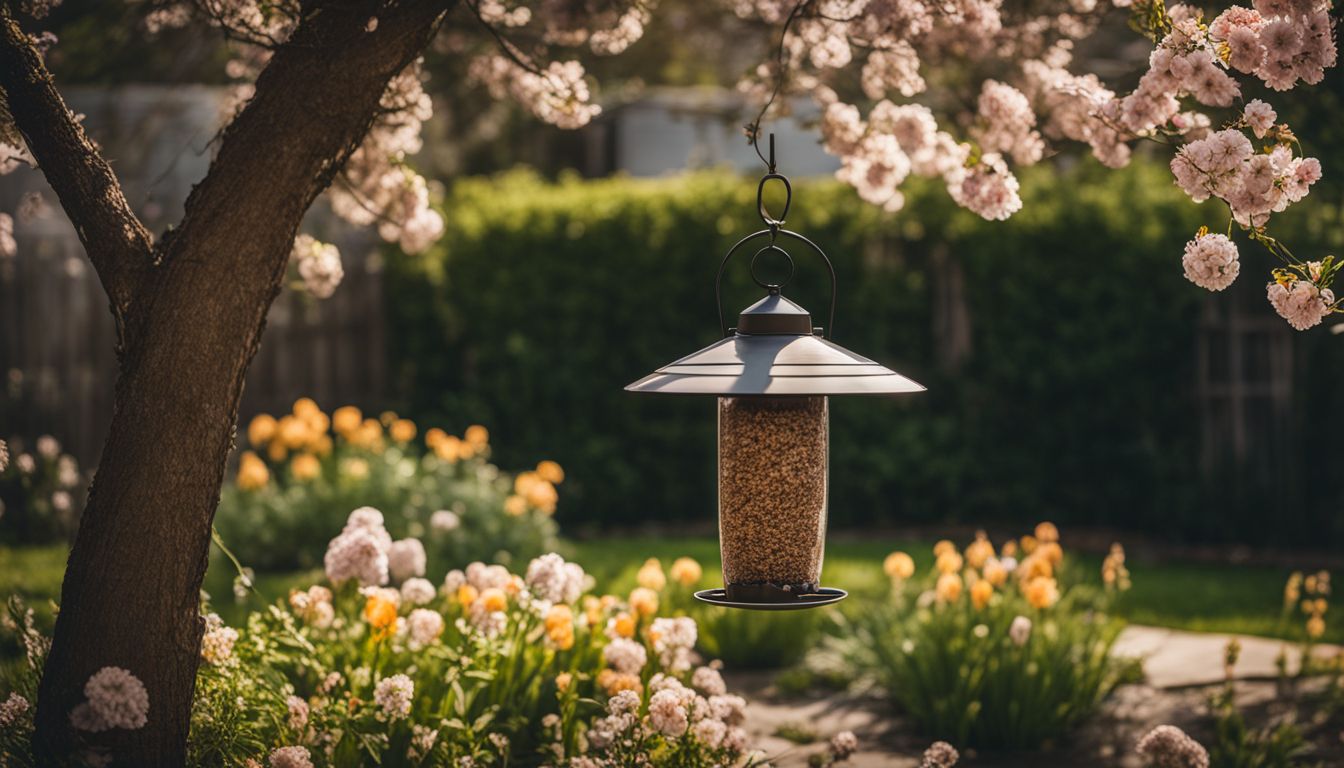
It’s essential to maintain bird feeders to keep them safe and effective. Here are the proper steps I follow:
- Clean the feeders with warm, soapy water at least once every two weeks to remove mold, bacteria, and debris.
- Rinse thoroughly and allow feeders to dry completely before refilling them.
- Use a small brush or pipe cleaner to clean out feeding ports or other hard-to-reach areas.
- Dispose of any moldy or spoiled food promptly to prevent birds from consuming harmful substances.
- Check for signs of wear and tear on feeders regularly and replace any damaged parts as needed.
- Refill the feeders with fresh seeds or suet as soon as they are empty, especially during harsh weather when birds may rely on them for sustenance.
Dealing with pests
When maintaining bird feeders, it’s essential to deal with pests effectively. Here are some tips for handling pests around your bird feeders:
- Clean up spilled seed regularly to prevent attracting rodents and other scavengers.
- Use squirrel – proof feeders or baffles to deter squirrels from raiding the feeders.
- Position feeders away from overhanging branches and structures to minimize access for squirrels and raccoons.
- Consider using caged feeders, which allow smaller birds to enter while keeping larger pests out.
- Utilize predator guards on poles to discourage predators like cats from accessing the feeders.
- Choose feeder designs that minimize spillage and waste to reduce the attraction of pests.
- Employ natural pest deterrents such as chili peppers in birdseed or hot pepper suet to repel mammals.
- Regularly inspect and maintain feeders for damage, ensuring there are no entry points for pests.
Etiquette Tips for Feeding Birds
– Remember to respect the birds and their natural behavior when feeding them. Avoid overcrowding at feeders, which can lead to potential conflicts between birds, as well as attracting non-native species.
– Consider the impact on the environment and choose food that minimizes waste and prevents pollution.
Respect the birds and their natural behavior
I always prioritize respecting the birds and their natural behavior when feeding them. It’s important to give birds space and not disrupt their natural activities, such as nesting or foraging.
By doing so, I can enjoy watching them in their element without causing any harm or stress.
I also make sure to consider the impact on the environment while feeding birds. This means using feeders that are safe for the environment and avoiding overcrowding that could attract non-native species.
Avoid overcrowding or attracting non-native species
To ensure the well-being of our feathered friends, it’s important to avoid overcrowding around bird feeders. Overcrowding can lead to stress and competition for food among the birds.
By providing multiple feeding stations, we can disperse the crowd and create a more peaceful dining experience for them.
When choosing foods to offer, it’s crucial to avoid attracting non-native species that may outcompete local birds for resources. Some non-native species can become invasive and disrupt the natural balance of the ecosystem, impacting native bird populations.
Consider the impact on the environment
Feeding birds can impact the environment in both positive and negative ways. Providing food for wild birds can offer a lifeline during harsh weather conditions or when their natural food sources are scarce.
However, bird feeding should be done responsibly to avoid unintended consequences such as attracting non-native species or contributing to the spread of diseases among birds. It’s important to use clean feeders and high-quality bird seed to minimize waste and ensure that our feathered friends get the nutrition they need without causing harm to their natural habitats.
Conclusion
In conclusion, feeding birds can bring joy and benefits to both wildlife and families. It is important to follow proper etiquette when feeding birds, considering factors like the timing, location, types of food offered, and maintenance of feeders.
By respecting the birds’ natural behavior and considering the impact on the environment, bird lovers can make a positive difference while enjoying the beauty of nature in their own backyard.
FAQs
1. What is bird feeding etiquette?
Bird feeding etiquette is a set of guidelines on how to feed birds responsibly in your backyard or garden, making sure it’s safe for the birds and follows local bird feeding regulations.
2. Why should I follow bird feeding best practices?
Following proper bird feeding practices helps keep wild birds healthy, protects them from harm, and makes sure that birdwatching stays fun and safe for everyone.
3. Can I feed birds all year round?
Yes, but you should adjust your feeding habits to meet different needs during various seasons according to recommendations by experts in ornithology.
4. What kind of food is good for backyard birds?
The best types of food depend on the kinds of birds you want to attract; however, there are general tips like avoiding bread and offering seeds, nuts, or fruit instead.
5. Are there rules about where I can put my bird feeder?
Yes! Your bird feeder should be placed where it’s easy for birds to find yet hard for predators to reach; also consider neighbors so that your feeder does not cause problems.
